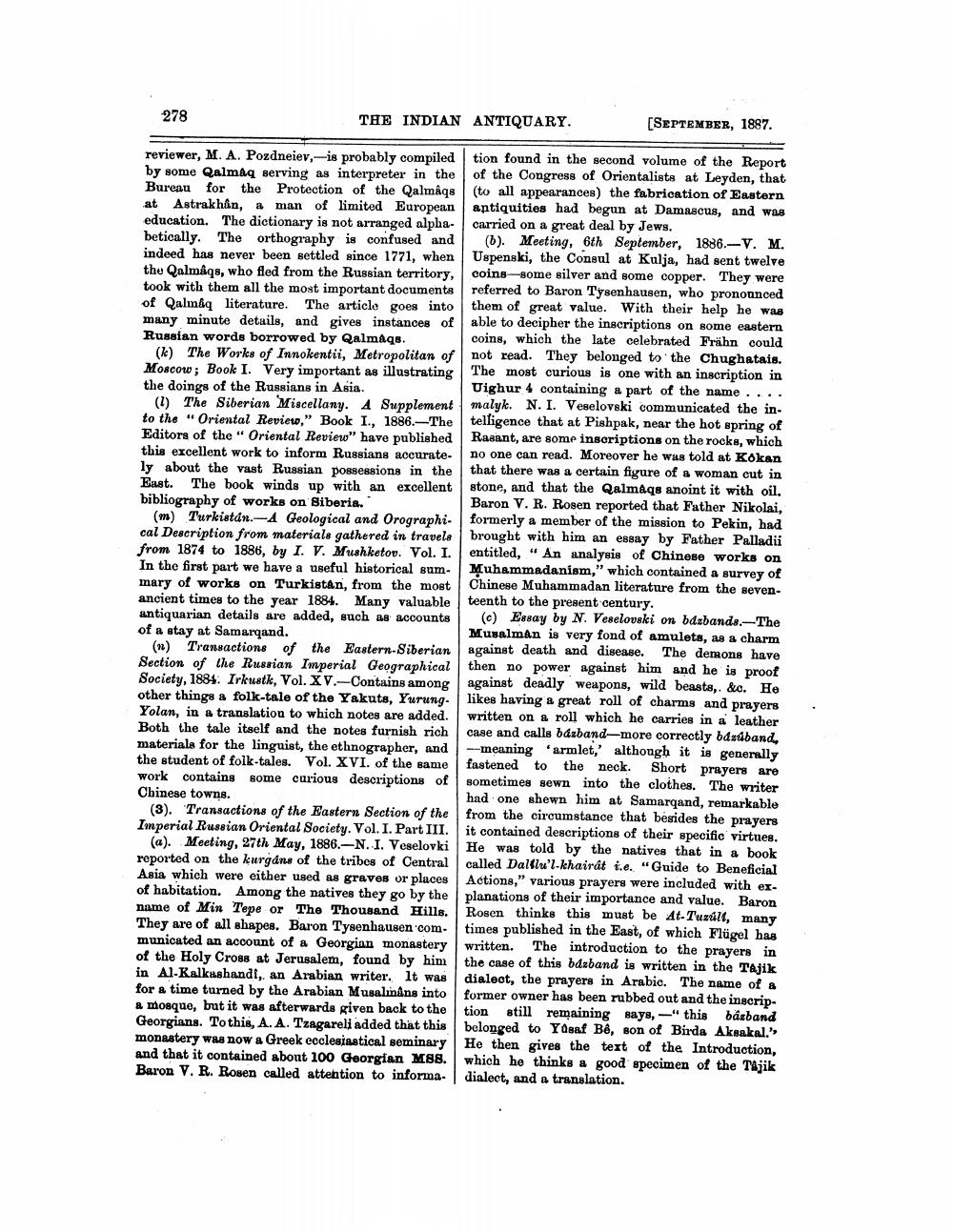________________
278
THE INDIAN ANTIQUARY.
[SEPTEMBER, 1887.
reviewer, M. A. Pozdneiev,-is probably compiled tion found in the second volume of the Report by some Qalmaq serving as interpreter in the of the Congress of Orientalists at Leyden, that Bureau for the Protection of the Qalmaqs| (to all appearances) the fabrication of Eastern at Astrakhân, & man of limited European antiquities had begun at Damascus, and was education. The dictionary is not arranged alpha- carried on a great deal by Jews. betically. The orthography is confused and (6). Meeting, 6th September, 1886.-V. M. indeed has never been settled since 1771, when Uspenski, the Consul at Kulja, had sent twelve the Qalmaqs, who fled from the Russian territory, coins--some silver and some copper. They were took with them all the most important documents referred to Baron Tysenhausen, who pronounced of Qalmaq literature. The article goes into them of great value. With their help he was many minute details, and gives instances of able to decipher the inscriptions on some eastern Russian words borrowed by Qalmaqs. coins, which the late celebrated Frähn could
(k) The Works of Innokentii, Metropolitan of not read. They belonged to the Chughatais. Moscow; Book I. Very important as illustrating The most curious is one with an inscription in the doings of the Russians in Asia.
Uighur 4 containing a part of the name .... (1) The Siberian Miscellany. A Supplement malyk. N. I. Veselovski communicated the into the "Oriental Review," Book I., 1886.-The telligence that at Pishpak, near the hot spring of Editors of the “ Oriental Review" have published Rasant, are some inscriptions on the rocks, which this excellent work to inform Russians accurate- no one can read. Moreover he was told at Kokan ly about the vast Russian possessions in the that there was a certain figure of a woman cut in East. The book winds up with an excellent stone, and that the Qalmaqs anoint it with oil. bibliography of works on Siberia.
Baron V. R. Rosen reported that Father Nikolai, (m) Turkistán.- A Geological and Orographi. formerly a member of the mission to Pekin, had cal Description from materials gathered in travele brought with him an essay by Father Palladii from 1874 to 1886, by I. V. Mushketov. Vol. I. entitled, "An analysis of Chinese works on In the first part we have a useful historical sum. Muhammadanism," which contained a survey of mary of works on Turkistan, from the most
Chinese Muhammadan literature from the sevenancient times to the year 1884. Many valuable teenth to the present century. antiquarian details are added, such as accounts (c) Essay by N. Veselovski on bdzbands.--The of a stay at Samarqand.
Musalman is very fond of amulets, as a charm (n) Transactions of the Eastern-Siberian against death and disease. The demons have Section of the Russian Imperial Geographical then no power against him and he is proof Society, 1884. Irkustk, Vol. XV.-Contains among against deadly weapons, wild beasts, &o. He other things a folk-tale of the Yakuts, Yurung. likes having a great roll of charms and prayers Yolan, in a translation to which notes are added. written on a roll which he carries in a leather Both the tale itself and the notes furnish rich case and calls bárband-more correctly bdadband, materials for the linguist, the ethnographer, and -- meaning 'armlet,' although it is generally the student of folk-tales. Vol. XVI. of the same fastened to the neck. Short prayers are work contains some curious descriptions of sometimes sewn into the clothes. The writer Chinese towns.
had one shewn him at Samarqand, remarkable (3). Transactions of the Eastern Section of the from the circumstance that besides the prayers Imperial Russian Oriental Society. Vol. I. Part III. it contained descriptions of their specific virtues.
(a). Meeting, 27th May, 1886.-N. I. Veselovki He was told by the natives that in a book reported on the kurgans of the tribes of Central called Dalflu'l-khairat i.e. "Guide to Beneficial Asia which were either used as graves or places Actions," various prayers were included with exof habitation. Among the natives they go by the planations of their importance and value. Baron name of Min Tepe or The Thousand Hills. Rosen thinks this must be At-Tuzült, many They are of all shapes. Baron Tysenhausen.com times published in the East, of which Flügel has municated an account of a Georgian monastery written. The introduction to the prayers in of the Holy Cross at Jerusalem, found by him the case of this bdsband is written in the Tajik in Al-Kalkashandt, an Arabian writer. It was dialoot, the prayers in Arabic. The name of a for a time turned by the Arabian Musalmans into former owner has been rubbed out and the inscripa mosque, but it was afterwards given back to the tion still remaining says, "this bårband Georgians. To this, A. A. Tzagareli added that this belonged to Yosaf Bê, son of Birda Aksakal." monastery was now a Greek ecclesiastical seminary He then gives the text of the Introduction, and that it contained about 100 Georgian M88. which he thinks a good specimen of the Tajik Baron V. R. Rosen called attention to informa. dialect, and a translation.




